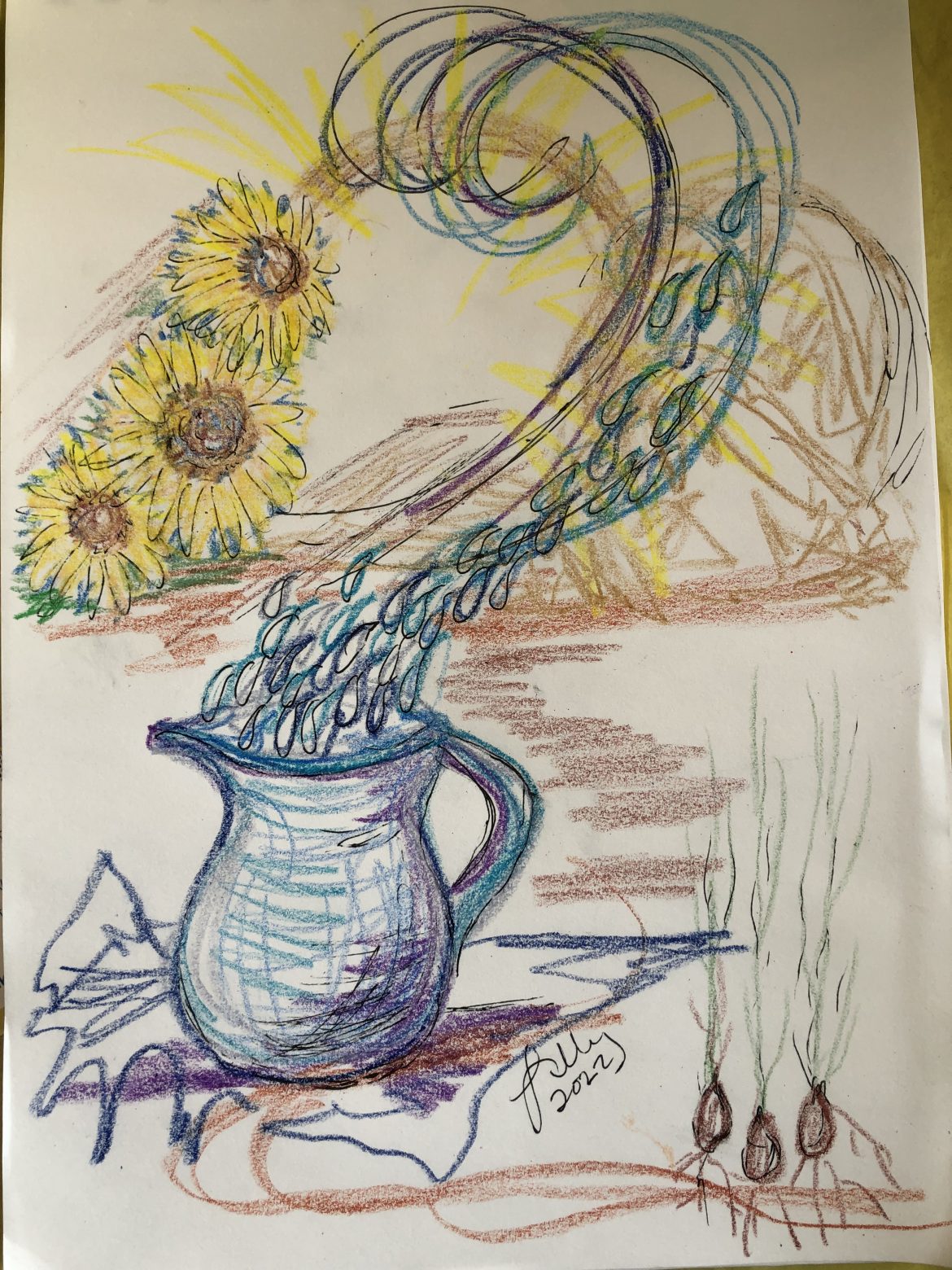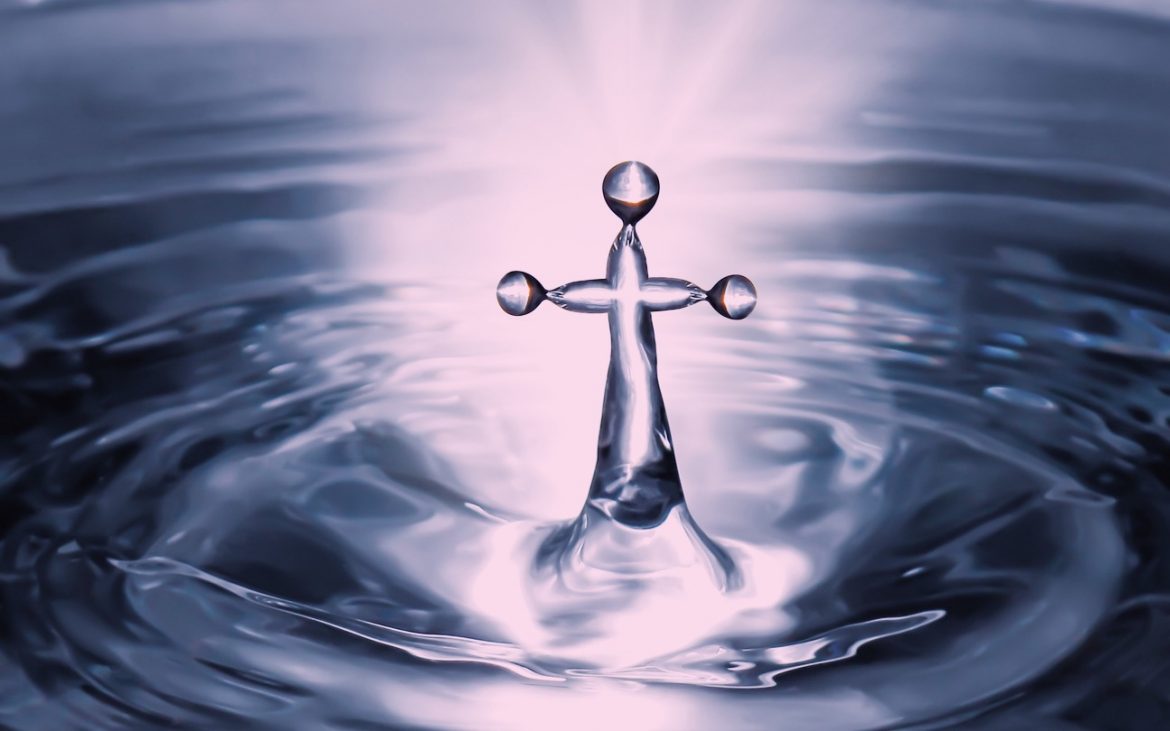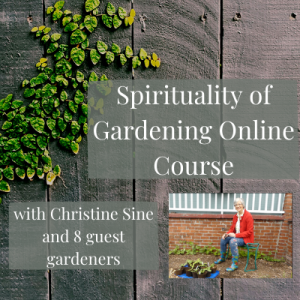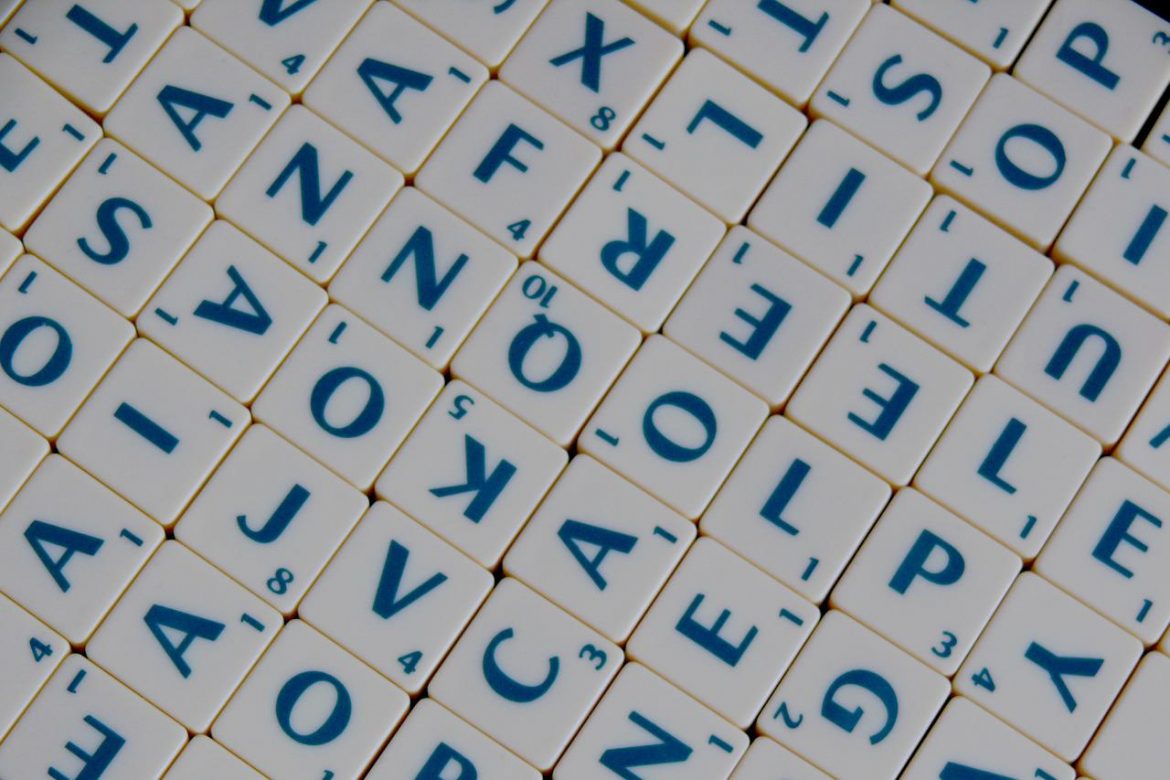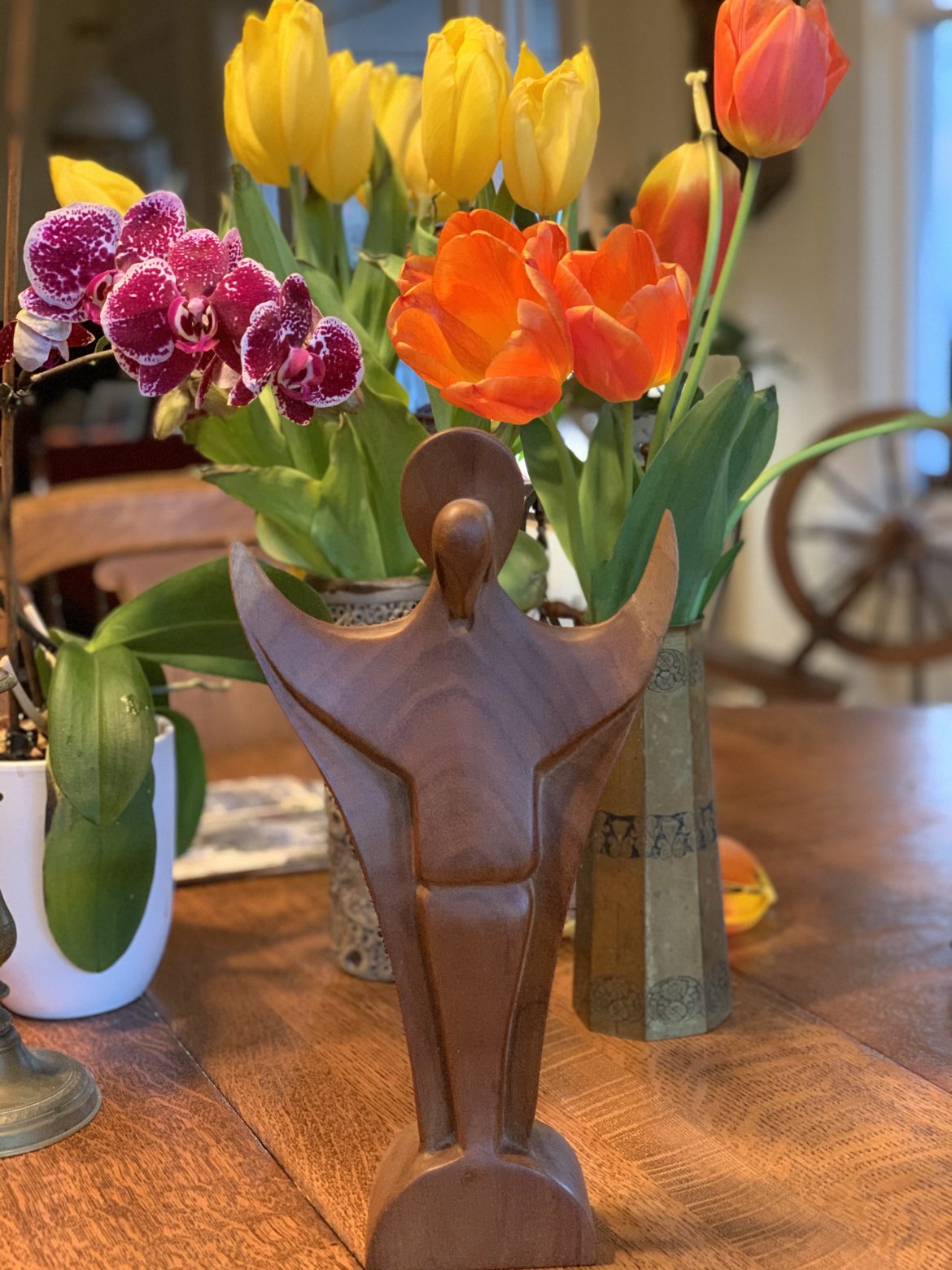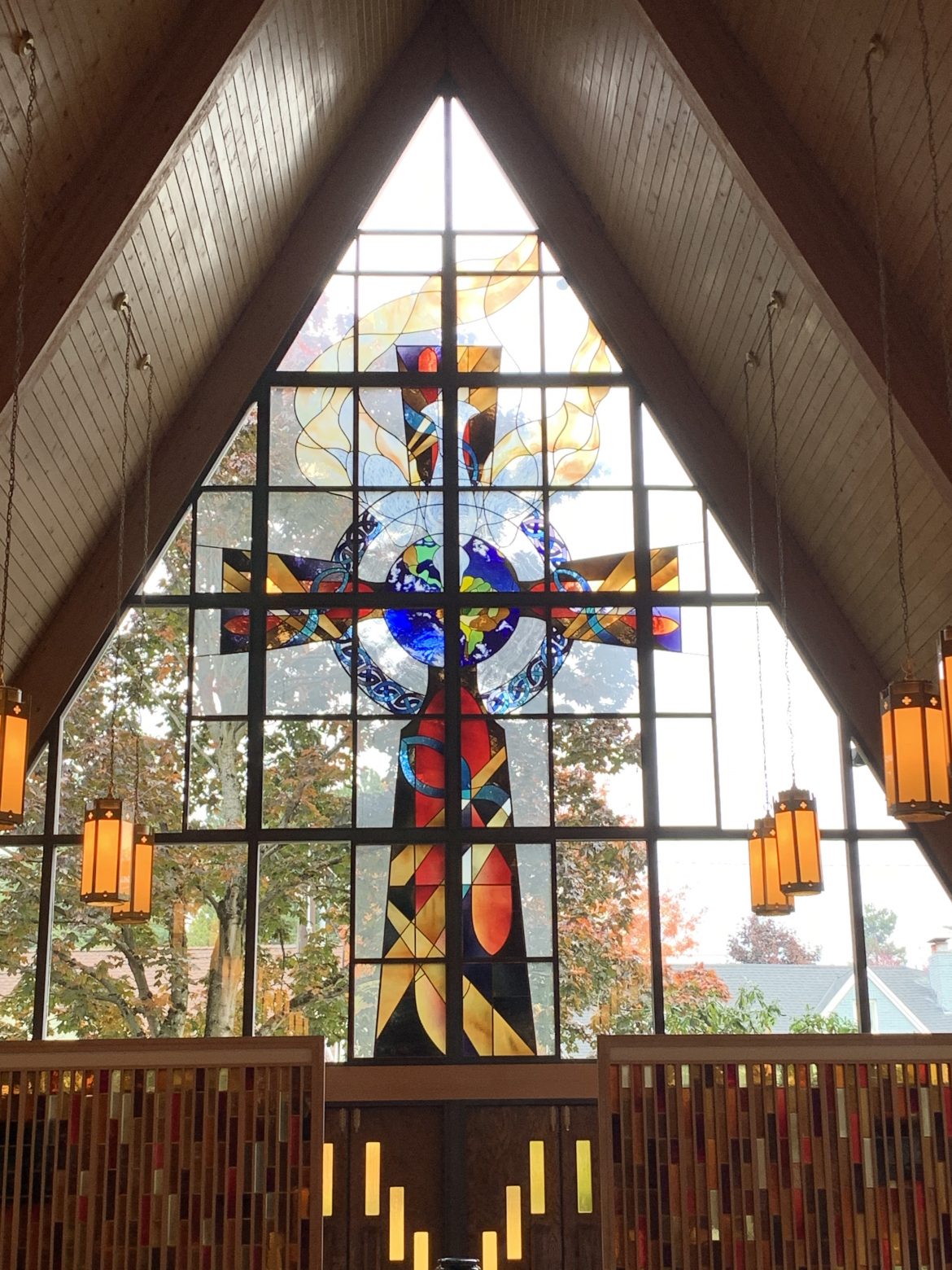By Tom Sine
Originally published on New Changemakers.
I still remember that first Earth Day on April 25, 1972 day very clearly. I was working as Dean of Students at Maui Community College. Dr. James Dator from the University of Hawaii presented a very alarming forecast of a host of environmental challenges that we were likely to face in the future.
As a young 37 year old I prided myself on keeping up on what we used to call “current events” but I had no sense the future was changing. Dr. Dator’s description of some of the environmental crises that were likely to come our way in the next two decades were chilling.
50 of the students were so unsettled they took immediate action. I followed them three blocks north of the campus to a motel that was right on the ocean. When we arrived I immediately saw huge mounds of garbage on the beach. The students collected over 50 large bags of garbage and took it into the lobby. Initially the manager exploded, however by 5 pm he caved in and hired a garbage service.
That First Earth Day brought me to Seattle to pursue a Doctorate at the University of Washington in Intellectual history and a minor in forecasting. My first professor, Frank Herbert, taught a class titled Utopia/Dystopia that revealed how deeply divergent our views of a desirable future are in both our history and our literature. The research for Frank’s classic book Dune was done by researching the dunes in southern Oregon and his strong concern for the well-being of our environment. Frank was not only a friend and a mentor he also shared my concern about the environment in Washington state. In fact, several other professors at the UW also wanted to see the state of Washington do more to create a sustainable environment.
My professors learned about several states who, in response to that first Earth Day, had instituted state futures projects including Maine Manifesto and California Tomorrow. Several of them took the initiative to arrange a meeting with Governor Dan Evans. They presented their rough ideas for instituting a Washington State futures project too.
A Surprising State Response to That First Earth day!
To their surprise, Governor Dan Evans – a Republican – was much more progressive than the governors in other states. Governor Evans instituted a process of inviting the participation of citizens all over the state to secure their ideas for the future of the state of Washington over a year. I was fortunate to attend the final citizens gathering at a Catholic retreat site outside of Seattle. One of the major areas of citizen concern was for the increased stewardship of the beautiful environment in Washington State. This was clearly expressed in Alternatives for Washington Volume II. That is available in many libraries in our state.
Alternatives for Washington was sponsored by the state of Washington and administered by the Office of Program Planning and Fiscal Management with the assistance of the Brookings Institution in Washington D.C., the University of Washington and Washington State University, and the US Department of Commerce.
The leading supportive goals for Environment Policies in the Alternatives For Washington stated the first goal: “Establish, monitor, and enforce air, water, and noise pollution standards on a regional basis to maintain a desirable environment and prevent adverse effects on public health.” P.164 Alternative for Washington, Daniel J. Evans Governor, VOLUME II October 30, 1974
What made Alternatives for Washington stand out among the other state futures projects was that Governor Dan Evans not only solicited citizen input during that year-long project; he actually drafted legislation that reflected citizen input before he left office.
Frank Herbert’s Final Response to that First Earth Day Was Not Surprising
When Frank Herbert retired in Port Townsend, Washington he never retired from his concern for the environment. In fact the first thing Frank did, when he moved to Port Townsend, was to build a huge windmill in his backyard. Then he purchased one of the earliest electric cars and he never went back to a gas station the rest of his life. By the way, I am currently enjoying the audio version of Dune on my weekly walks around Green Lake… a version of Dune I strongly recommend.
I Urge Us All To Join Gen Y & Z, who are most aware that we only have two decades to turn this global environmental crisis around. Many of these young people have the Highest Commitment to preserving our planet for their children’s generation. I Urge All Those Who Are Followers of Jesus to join those who are working to preserve this amazing planet for all of our children and grandchildren…while we also pray for peace in Ukraine!
I am still working with church leaders to join those who are taking the future seriously. Do check out our current book I wrote with Dwight J. Friesen 2020s Foresight:Three Vital Practices For Thriving in a Decade of Accelerating Change.
I would welcome your response: twsine@gmail.com
Join Tom on New Changemakers for a series of posts that will be an invitation to join those who are caring for God’s Creation
- We will start with Celtic Christian’s devotion to creation
- We will share Randy Woodley”s Becoming Rooted: One Hundred Days of Reconnecting With Sacred Earth
- We will share Circlewood An invitation to join Creation Care
Photo by Dustan Woodhouse on Unsplash
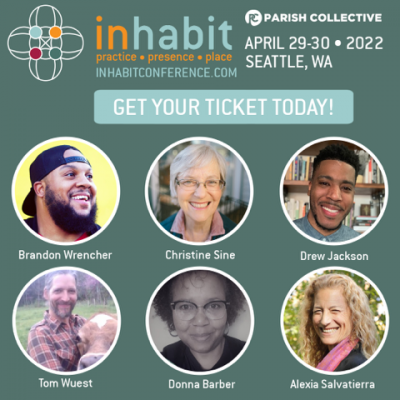 Join Christine Sine, Tom Sine, and others for Inhabit 2022 on April 29-30th in Seattle- a live conference by Parish Collective. Explore stories of hope and be encouraged to be the church in your neighborhood. You are not alone – the everyday realities are carried by us all. Click here for more info!
Join Christine Sine, Tom Sine, and others for Inhabit 2022 on April 29-30th in Seattle- a live conference by Parish Collective. Explore stories of hope and be encouraged to be the church in your neighborhood. You are not alone – the everyday realities are carried by us all. Click here for more info!
Did you know that 220 million people are celebrating Easter this Sunday, April 24th? The Orthodox Church is the second largest Christian Church after the Catholic Church. That means that a large portion of Christians are remembering Good Friday and Holy Saturday today, depending upon their time zone! This also means that our Orthodox friends in Ukraine AND fellow Christians in Russia will be celebrating Easter this weekend!
It’s a great reminder to pray for PEACE and an END to war!
It’s a great reminder to pray for Miracles!
And to pray for the end to the death and destruction of this conflict and all the pain it is causing!
I need to be reminded that people are suffering on both sides of this horrific conflict. Especially those who want PEACE and those who are poor. This past weekend, on Easter Sunday, Reverend Becca Stephens reminded us that Ukraine is the breadbasket for Europe and much of their grain goes to Africa too! So this war is causing a crisis for the food supply globally. Farmers are suffering because they should be planting now! One way to help is through SEEDS. St. Augustine’s here in Nashville is collecting seeds and money for seeds to help farmers in Ukraine. You can find out more at the link.
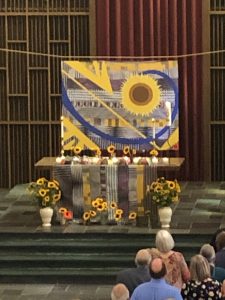
St. Augustine’s EASTER Service
Other organizations like Doctors without Borders and World Central Kitchen are helping on the ground and need our support and prayers.

Pray with Sunflowers
WAYS TO PRAY…with SUNFLOWERS AND TEA!
You probably know now that the Sunflower is the National flower of Ukraine. (learn more here)
A great reminder to pray for UKRAINE and the end of the War, and for refugees, etc. is to find a photograph of a Sunflower or buy some sunflowers and have a visual reminder to pray.
The national flower of Russia is the Chamomile, a symbol of healing. Find some Chamomile tea and make it a daily practice to drink the tea and pray for healing in our world, in Russia and Ukraine, pray for peace and those working for peace around the world and especially in Russia.
Breathe in the scent of the tea as well as tasting it!

Drink some Chamomile Tea
LISTEN TO :
Kyiv Symphony Orchestra and Chorus sing “Christ the Lord is Risen Today”
A Ukrainian Prayer by John Rutter
God, we are heartbroken for our Ukrainian siblings
For all who are suffering, For all who are displaced, For all who are fighting, For all who are dying, For all who are fearful, For all who are resolute, For all who feel hopeless.
We are sad and sick at heart That war has once again been waged on innocents, on anyone. We lament and mourn this tragedy . And commit to lending our strength and love to those in the fight, Even as we ask for all bloodshed to cease. As Christ has shamed violence, so do we.
Jesus forgave his enemies and loved them even from the cross,
We are commanded to love our enemies and pray for them.
We pray for all in Russia who are suffering.
For all who are displaced, For all who are fighting, For all who are dying, For all who are fearful, For all who are resolute, For all who feel hopeless.
Lord Jesus your RESURRECTION is about a whole new way of living!
Help us to live out love.
Help us to live out peace and live out and stand up for justice. In your Name! AMENPrayer based on a Litany for Ukraine by Rev Fran Pratt
Pray with chamomile tea
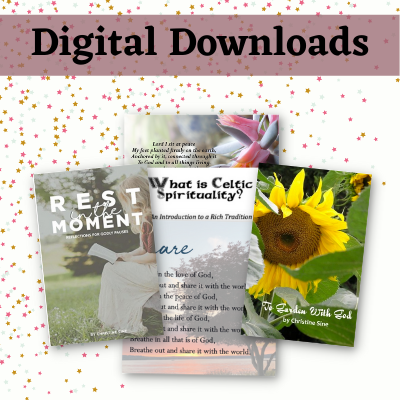 Did you know? We have many resources available for downloads–from books to retreats, cards and coloring pages, and much more–including free resources! Check out our shop here for all the fun!
Did you know? We have many resources available for downloads–from books to retreats, cards and coloring pages, and much more–including free resources! Check out our shop here for all the fun!
all words and images by Kate Kennington Steer
Between April and August 2021 Creative Response Arts was working with performance poet Justin Coe and the Space2Grow community garden project from Farnham, Surrey to make a site-specific arts installation and to publish a book of written responses to the garden, its users, and volunteers. As part of the writing group, I was hoping to spend several long summer days in the Space2Grow acre, by the pond, maybe helping pick fruit or to hoe a row of veg, in between working at various writing exercises with a small-yet-wonderful group of other writers (who had never occupied the same physical space and time together). Sadly, it became apparent that the Space2Grow garden wasn’t yet fully wheelchair accessible and so I would be unable to join the group on these Garden days, getting to know the space to which we were to respond. Instead, I decided to shift my focus slightly and base my own work on what I could experience from my beloved Mum’s ‘greenhouse garden.’ What emerged was a sequence of thirty poems entitled ‘growing space.’ Some of these finally found their way into the group anthology ‘Where Seeds Are Planted Poems Grow’. This book was due to be launched during the Farnham Literary festival in early March, and since I was unable to be physically at the launch, I made several (really basic) short films, each no longer than three minutes, of me reading a selection of my poems included in the anthology.

As part of the celebrations and demonstrations around Earth Day/Earth Hour, I offer a couple of these short films to the Godspace community. For me, each word, photo and painting that together constitutes my ‘growing space’ sequence, is a miracle of grace: a dis-abled, isolating moment of potential exclusion was transformed into an opportunity for learning, expansion and community. It feels like my own personal parable of just one instance where beauty has emerged from ashes – again – to surprise and stagger me into remembering the Presence of the One who continues to Grow is beside me throughout …
growing space xviii
come into the garden of colour
dig down through the undercroft of umber
be bedappled below sunfiltered lime
interweave between smoked rounds of plum
and orange-zest edged in iridescent pink
breathe in lungfuls of rose for rest, then,
wander through the meadow of waving
white daisies turned pointillist painting
by cornflower, nigella and canterburybell blues
highlights of red campion, mauve borage
shadows of dusky lavender leaning into indigo
sit amongst the sunflowering solarseekers
let your face reflect buttercup gold
warm yourself beside the spiced flames
of marigold, nasturtium and yarrow
wade through waters become skywindows
duck-egg-shell wash under the cream-centred
lilies as they float, fill, tip, empty, float, fill, tip,
empty their rainbowed balm over your feet
seek your palette here where shades
display all their hues, shuffling in intensity
as the light falls, conjuring new dynamics
and harmonics at the moon’s rise
you who know your colour, come, rejoice,
you who can only feel alien in your skin
come, explore, and let the comfort
of colour find you, here, where
each tone has its tune, come,
bring your voice to add its riches
the garden of colour welcomes allcomers.
growing space vi
to become human again
make your own ritual:
before you dance,
sit quiet,
breathe
into this place,
receive
its’ breath into you;
be your own education:
hear the ant scurrying concrete,
watch the blackbird scuffing soil,
follow the petal’s unfurling
attune to the arc of the sun;
find your own purpose:
soak yourself in wind and rain,
saturate yourself in the orange
warmth of peeling brick,
shelter yourself in the shivering blue
shadows under eaves,
let the eyes of your heart
sink deep into scent,
inward and outward be opened,
listen to your own knowledge take deep root,
awake to the pulsations of connecting
and permit them to propel you
to where you are most needed;
accept your own responsibility:
bend your head and allow
this benediction of green
to flow over you,
blow through you, and then,
only then, find your means
to pass on such blessing
to another.
Editor’s Note: If you’d like to see more of our author Kate Kennington Steer’s poetry read, you can check out her YouTube channel here!
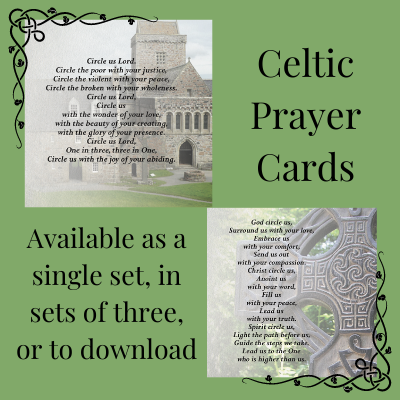 Celtic Prayer Cards include 10 prayers inspired by ancient Celtic saints like Patrick or contemporary Celtic writers like John O’Donohue. A short reflection on the back of each card will introduce you to the Celtic Christian tradition, along with prayers by Christine Sine and beautiful imagery crafted by Hilary Horn. Celtic Prayer Cards can be used year-round or incorporated into various holidays. Available in a single set of 10 cards, three sets, or to download.
Celtic Prayer Cards include 10 prayers inspired by ancient Celtic saints like Patrick or contemporary Celtic writers like John O’Donohue. A short reflection on the back of each card will introduce you to the Celtic Christian tradition, along with prayers by Christine Sine and beautiful imagery crafted by Hilary Horn. Celtic Prayer Cards can be used year-round or incorporated into various holidays. Available in a single set of 10 cards, three sets, or to download.
by Diane Gagné
Whether the point of view is social, political, economic psychological, generational, religious, spiritual, or so on…
It remains a point of view, an opinion, a way of looking at things. The angle can be very wide or very narrow, it will attract, or it will stir, according to the modes and the transient currents.
No matter…
If there is a concern to please or to displease, a need to be seen or be recognized, a feeling of having to protect or convince…
As long as these aspects remain more important than joy, peace and love…
The point of view is still needed to hang on to these little bits of truth, comforting and reassuring a vulnerability, a sensitivity and a fragility still perceived
like elements to fight or to hide.
It is easier to lie to oneself, to hide, to tell stories, than admit defeat, weaknesses, shortcomings and misunderstandings.
We are reborn and resurrected many times, not just in these springtimes filled with metaphorical images of rebirth with rabbits, eggs or Easter water.
We die, we are crucified throughout our life, and pain is not just that unique moment of the year when Christ is seen in all his suffering on the cross.
The armor and the shell must be broken by our resistance and so many «let go».
The illusions must clash with themselves again and again.
Before realizing that…
Everything is true of course. But it is also true that everything is false. Again, it’s a way to look at things, to embrace things…
Nested and merged, Truth dances with illusion at each moment. Truth has nothing to do with theories, points of view, dogmas and opinions. Truth mocks to be right or wrong, got nothing to gain or to protect and it is only us, who are still there, trying to protect us or make us allies.
Truth is…
« I Am This »
All this… Around us and within us, just asking to be seen and welcomed.
Asking to be seen in its perfect imperfection.
No, being reborn doesn’t just happen once a year, it’s at the very heart of every moment of life.
Photo by Ryoji Iwata on Unsplash
Diane Gagné is an author and speaker. Her focus is a state of peace, deep bliss, and boundless love for the sacred meaning of Life. She doesn’t teach any particular tradition, although she was profoundly influenced by non-dual approaches and Christianity. A former lawyer of 25 years in the northern Canadian town of Rouyn-Noranda, Diane channels her deep life experiences on the roller coaster of the soul into the new Reality she has found. You can find her writings here, in her mother tongue of French as well as translated into English.
Explore the wonderful ways that God and God’s story are revealed through the rhythms of planting, growing, and harvesting. Spiritual insights, practical advice for organic backyard gardeners, and time for reflection will enrich and deepen faith–sign up for 180 days of access to work at your own pace and get ready for your gardening season.
What’s In A Name?
An excerpt from Back To Life- Experience Your Own Resurrection – a Liturgical Guide for Easter from Sacredise.com
I lived in eleven different homes, in three different continents in the first seven years of my life. My father’s work meant that my family moved often. For my tiny, sensitive, introverted soul, this was a lot to cope with. But what made it possible for me was my security pillow with its dog picture on the front and shaped to match. Everywhere I went my pillow was firmly tucked under my arm. My mother tells me that, as we moved through the various airports, she would put me on the trolley with our luggage and I would put my head on my pillow and go to sleep. I don’t remember when I stopped clinging to my dog pillow, but I do remember the pillow itself clearly and very fondly.
It was appropriate and very helpful for me to carry my dog pillow around with me as a small child traveling the world. But if I had tried to take it with me to my first day of school that would have been less appropriate. If I had kept it beside me through high school, or laid it on my desk as I attended university lectures, or had it on my lap in my first job interview, that would have been dysfunctional. What was normal for me as a child is abnormal for me now as an adult. I still have important objects that hold meaning for me. And some of them may even seem juvenile or strange to others. But I engage with them as an adult in an adult way, not as an attempt to cling to my childhood.
What makes this Easter different from the last two years is that the first signs of an end to the pandemic are beginning to appear. We’re not out of the woods yet, but we can begin to imagine a life that is no longer restricted by COVID protocols. And that can make the temptation to cling to what we’ve known seductive. When we think of a return to normal, it is tempting to look back. We naturally long to return to what we’ve known, even if it is now beyond our reach. But we can’t get back to life by going back. The life, the resurrection we seek is ahead of us, in the new world that is, as yet, unknown.
In the resurrection narrative of John’s Gospel, Mary Magdalene tried to cling to the Risen Jesus who had just made himself known. But he discouraged her and helped her to see that he, her relationship with him, and their world, were all changed. She could not cling to what she knew. That reality was gone. The life she now sought was not behind her but ahead.
Jesus had already prepared her to cope with the new reality. Although at first she mistook him for the gardener, he opened her eyes by speaking her name. This was not just saying a label. It was an act of recognising her for who she was, of celebrating her and all that her name meant and embodied. Her relationship with Jesus had always been based on his capacity to make her feel truly seen—perhaps as no one else ever had.
I often wonder how Jesus spoke her name. Did he simply say it as an affirmation of her presence? Or did he voice it with a smile as a gentle question, “Seriously, Mary? You don’t recognise me the way I recognise you?” Perhaps he looked her in the eye and spoke it as a reminder of her strength and uniqueness. Whatever the case, when he named her he empowered her to rise up, embrace her new reality, and share her experience with the other disciples. He led her back to life not by clinging to the past, but by stepping confidently and hopefully into the unknown future.
We cannot know fullness of life, we cannot be resurrected into our most abundant, meaningful life unless we know what it is to be fully seen, truly named, and completely loved. And that’s why the Scriptures are so consistent in speaking about the importance of our names. The psalmist, without specifically mentioning names, celebrates being fully and lovingly known by God in every way (Ps.139). When the people of Israel cry that God has forgotten them, Isaiah brings a divine word that says, “See, I have written (some other versions say engraved or inscribed) your name on the palms of my hands.” (Isaiah 49:15). In Jesus’ parable of the rich man and Lazarus, it is the poor beggar who is named in contrast to the wealthy man who ignores him (Luke 16:19-31). When Jesus calls Simon he gives him a new name to express both the giftedness and strength that Jesus sees in him and his new calling among the disciples (John 3:42). Nathaniel’s skepticism is overcome when Jesus describes seeing him under the fig tree before Philip called him and affirms him as a “genuine son of Israel—a man of complete integrity” (John 3:47). And here, Jesus names Mary and sends her as the first apostle to share the news of resurrection.
If we long to get back to life again, to experience our own resurrection, we can begin by remembering that we are named, seen, and loved by God—just as we are, regardless of what life and the world have taken from us or how others have mis-seen us. All we need to do is learn to believe it and live into it—which is, I confess, easier said than done. And that’s why we need each other. As we intentionally and lovingly see and name one another, so we remind each other of God’s love and God’s seeing of us all. And as our souls learn to trust that we are truly and fully named, seen, and loved, so we can find the courage and strength to move forward into the life, the resurrection, that awaits us beyond the pandemic—or any other tragedy or trauma that we may have had to deal with.
We don’t know what the post-pandemic world will look like. But we do know that we cannot avoid it. We cannot go ‘back to Egypt’. We cannot return to normal in the sense of having again the life we once knew. Like Mary, we have to let go of our temptation to cling to the past, the familiar, the safe, and we have to step into the new reality that awaits us—whatever it may be.
And the thing that empowers us is to know that we are known; to experience, daily, that we are fully and truly seen, that we are enthusiastically celebrated, and that we are unconditionally loved. This is what Christ gives us as he speaks our names and engraves them on the palms of his hands. And this is what he asks us to give to one another as we embody for each other, the seeing, knowing, and loving of Christ.
Who needs you to name them today? Who needs to know that you see them? Who needs to feel God’s love expressed through you? And how will you make sure that you speak that person’s name warmly, respectfully, and with deep celebration and gratitude for who they are?
Editor’s Note: This is an excerpt from our author John van de Laar’s new resource Back to Life – just in time for right now, the season of Easter. You can find it through our Lent/Easter resource page, from John’s website Sacredise.com, and directly here.
Featured photo is from Pixabay
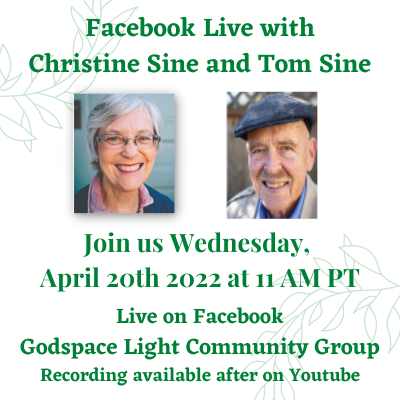 TOMORROW! Wednesday, April 20th at a *special* time of 11 am PT, join Christine Sine and Tom Sine for a discussion on Earth Day. Live on Facebook in the Godspace Light Community Group at 9am PT. Can’t join us live? Catch it later on youtube!
TOMORROW! Wednesday, April 20th at a *special* time of 11 am PT, join Christine Sine and Tom Sine for a discussion on Earth Day. Live on Facebook in the Godspace Light Community Group at 9am PT. Can’t join us live? Catch it later on youtube!
Easter is over – or is it? The Easter season now stretches before us extending to Pentecost on June 5th and I want to make sure we make the most of it. This is the season to celebrate the new life that Christ brought into the world and this year I plan to do that by focusing on our new Godspace theme Restoring Rhythms and Seasons. When I introduced this theme to our writers I told them I particularly wanted to focus on “how do we re-anchor our lives in the earth’s story. In his recent book Worshiping in Season – Ecology and Christ Through the Liturgical Year Joseph E Bush Jr states:
Throughout the Christian drama, creation is centrally involved, not only as the stage on which the play is set but also as the object of Christ’s love and the very terrain of salvation history. (Worshiping in Season – Ecology and Christ Through the Liturgical Year xi)
I am more and more convinced that whether we live in the city or the country, we need to listen to the earth and how its rhythms are meant to guide our lives. How far we have strayed from this was reinforced for me in an article I read last week on strategies for making the most of every day. I cringed because every suggestion focused on work and productivity. Not a single one acknowledged the importance of creation in the rhythm and purpose of our days. So I decided that as a beginning place for restoring God’s intended rhythms for our days I would make my own list. Of course some of these suggestions I have talked about before, and they don’t all revolve around creation, but I find I need constant reminders to keep me on track and I suspect you do too.
Ten Strategies for Making the Most of Every Day
- Listen – begin the day with prayer or scripture reading or meditation. Whatever brings light and life to your soul is an important place to begin each day. If you can draw an element of God’s creation into that practice, as I do by focusing on my contemplative gardens, I think you think you will find even more nourishment for your soul.
- Sit with God – invite the presence of God into every project you embark on throughout the day with a short prayer. One of the things I love about Celtic Spirituality is the rich prayer life that meant ordinary people prayed as they lit the fire, planted the seed and walked on a journey. With a little creativity we can craft prayers for our daily tasks too.
- Breathe – punctuate your day with stretches and breathing breaks. Did you know that as we grow older our breathing becomes shallower and taking a deep breath is a more conscious effort? For both our physical and spiritual health taking deep breaths for a minute or two at regular intervals throughout the day is rejuvenating. You might like to use one of the breath prayers I have written over the years, or go outside and take a few deep breaths. My favourite is a quick walk around a small part of my garden while I do that. If you think that the air you breathe is too polluted or too filled with allergens, or if your work environment won’t allow it, take a quick walk to the lunchroom or go talk to a colleague across the room instead of sending them an email. Take some deep breaths as you walk.
- Exercise – daily exercise is good for both our physical and spiritual well-being. For me that means awe and wonder walks each day. A great way to connect to God’s creation in my neighbourhood.
- Spend time in nature – you might prefer to get your exercise in a gym, but how about sitting in the local park a couple of times a week for lunch? You may not like gardening like I do but how about a nature walk or visit to the beach? For some of us getting out into nature is not easy, but the more we do it the more we find it enriches our souls.
- Be Hospitable – now that we are able to get out and about again many of us feel that we need to relearn the art of hospitality, but there are simple ways we can connect to the people around us throughout the day. A greeting to the cashier in the grocery store, a smile and hello to the homeless person at the corner, a cup of coffee for a coworker are all simple ways to show the gift of hospitality to those around us.
- Have some fun – when I asked my Facebook friends “have you had your daily dose of fun?” several commented “I am too busy for that.” Sad. Jesus encourages us to “become like children” and we can’t do that without getting out and having a bit of fun. Playing, laughing, doodling, reading a children’s book are all activities that enrich our lives and return God’s intended gift of play back into our daily lives. (And if you haven’t read it yet you might like to get a copy of my book The Gift of Wonder to help you on the way.)
- Take a nap. Did you know that people who take an after lunch nap are so much more productive afterwards that those who don’t nap cannot equal their productivity? Lots of high-powered execs take daily naps. I know this would be hard for a lot of people but even a short nap at your desk can make a difference. Or perhaps you can gather some of the research on this, present it to your boss and suggest that everyone in the office has 1/2 hour for a nap each day!
- Take screen breaks. Did you know that looking at computer screens all day can ruin our eyes. Take a break every hour. These breaks don’t have to be for long periods of time. Every hour or two, take a few minutes to get up, go for a short walk, and stretch your arms and legs. Yes you’re right this can be combined with several of the other suggestions above. All you need to do is figure out the best way for you to combine them.
- Give thanks. Ending your day with prayers of gratitude, keeping a gratitude journal that you write in each evening, composing a gratitude prayer you can say before you go to bed are all ways to end our day by giving thanks to God for the goodness of the day that has passed. One exercise I find particularly helpful is to write down three good things that happened during the day and thank God for them. When I focus on thanking God for the goodness God blessed me with it is amazing how my perspective on struggles can change. I hope it does for you too.
NOTE: As an Amazon Associate I receive a small amount for purchases made through appropriate links. Thank you for supporting Godspacelight in this way.
 Join Christine Sine, Tom Sine, and others for Inhabit 2022 on April 29-30th in Seattle- a live conference by Parish Collective. Explore stories of hope and be encouraged to be the church in your neighborhood. You are not alone – the everyday realities are carried by us all. Click here for more info!
Join Christine Sine, Tom Sine, and others for Inhabit 2022 on April 29-30th in Seattle- a live conference by Parish Collective. Explore stories of hope and be encouraged to be the church in your neighborhood. You are not alone – the everyday realities are carried by us all. Click here for more info!
A contemplative service with music in the spirit of Taize. Carrie Grace Littauer, prayer leader, with music by Kester Limner and Andy Myers.
Permission to podcast/stream the music in this service obtained from One License with license #A-710-756 with additional notes below:
“Were You There (When They Crucified My Lord)” Traditional Black American Spiritual, Arrangement by Kester Limner, shared under the Creative Commons license, attribution (CC-BY)
“Jesus the Lord is Risen (Surrexit Dominus Vere II)” Copyright and all rights reserved by GIA/Les Presses de Taizé
“Rabboni Beloved” By Kester Limner and Andy Myers, shared under the Creative Commons License, Attribution (CC-BY)
“Even In Sorrow” Composed by Kester Limner in March 2020 for the people of St. Andrew’s Episcopal Church in Seattle, shared under the Creative Commons License, Attribution (CC-BY)
Thank you for praying with us!
As an Amazon Associate, I receive a small amount for purchases made through appropriate links.
Thank you for supporting Godspace in this way.
When referencing or quoting Godspace Light, please be sure to include the Author (Christine Sine unless otherwise noted), the Title of the article or resource, the Source link where appropriate, and ©Godspacelight.com. Thank you!


